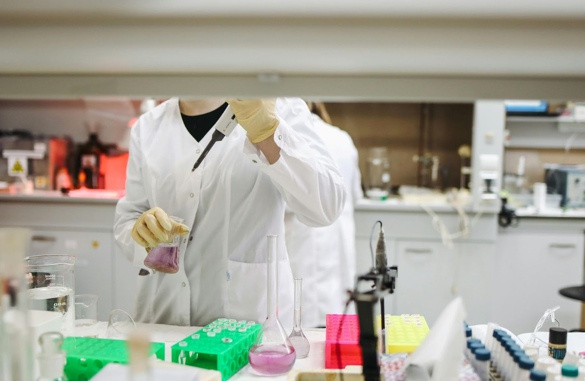
@ShahidNShah


Bioconjugation is revolutionizing medicine by enabling precise targeting and enhanced efficacy of drugs and diagnostic tools.
This powerful technique combines biological molecules with synthetic compounds, opening up new possibilities in biotechnology and healthcare.
Bioconjugation’s versatility extends to nanoparticle-based drug delivery systems, where it facilitates the creation of structures that can target specific cancer receptors. This advancement may lead to more effective and less invasive treatments for various diseases, potentially transforming healthcare options in the near future.
Bioconjugation involves the controlled linking of molecules to create new compounds with enhanced properties.
It is used in many different applications. For example, biotechnology companies like LifeSynth Solutions rely on bioconjugation to provide a range of services, from enzyme conjugates to immunogen preparation.
This process relies on specific chemical reactions and techniques to join biomolecules precisely and selectively.
Bioconjugation chemistry centers on forming covalent bonds between molecules, often utilizing functional groups like aldehydes and azides. Click chemistry, a popular approach, offers high yields and specificity.
Staudinger ligation and oxime ligation are other key reactions in your bioconjugation toolbox. These bioorthogonal reactions allow you to modify biomolecules under physiological conditions without interfering with native biochemical processes.
Enzymes can catalyze certain bioconjugation reactions, increasing precision and yield. You’ll find that controlling oxidation states of reagents is crucial for successful conjugations.
When performing bioconjugations, you’ll employ various techniques to achieve desired outcomes. Selective conjugation methods allow you to target specific sites on molecules.
To analyze your bioconjugates, you’ll use techniques such as:
These methods help you confirm successful conjugation and assess product purity. Fluorescent dyes and quantum dots are often used as labels to track bioconjugates in biological systems.
Your analysis should focus on:
Precise characterization ensures your bioconjugates maintain their intended functionality for research or medical applications.
Bioconjugation techniques have revolutionized medical applications, enabling targeted therapies, advanced diagnostics, and innovative research methods.
These approaches enhance drug delivery, improve disease detection, and facilitate groundbreaking studies in molecular biology and biotechnology.
Bioconjugation plays a crucial role in developing advanced drug delivery systems. You’ll find this technology particularly useful in creating antibody-drug conjugates (ADCs), which combine the specificity of antibodies with potent therapeutic agents. ADCs target cancer cells more precisely, reducing side effects on healthy tissues.

Polyethylene glycol (PEG) conjugation, or PEGylation, improves the pharmacokinetics and biodistribution of drugs. This technique extends the half-life of medications in your bloodstream, allowing for less frequent dosing.
Bioconjugated nanoparticles offer another avenue for targeted drug delivery. These tiny carriers can be engineered to release their payload in response to specific stimuli, such as pH changes or enzyme activity at disease sites.
Bioconjugated nanoparticles have transformed diagnostic capabilities. They enhance the sensitivity and specificity of various detection methods, allowing you to identify diseases at earlier stages.
In immunoassays, bioconjugated antibodies or antigens improve the accuracy of tests for infectious diseases, cancer markers, and hormone levels. These conjugates can be linked to fluorescent dyes or enzymes for easy detection.
Bioconjugation techniques also enable the development of multimodal imaging probes. These probes combine different imaging modalities, such as MRI and fluorescence, providing you with more comprehensive diagnostic information.
Bioconjugation drives innovations in molecular biology and cell surface engineering. You can use these techniques to study membrane-associated glycans and their roles in cellular processes.
Activity-based protein profiling, enhanced by bioconjugation, allows you to investigate enzyme functions in complex biological systems. This approach helps identify potential drug targets and elucidate disease mechanisms.
Bioconjugated synthetic polymers are used to mimic natural oligosaccharides, enabling studies on glycobiology and immune responses. These tools provide insights into fundamental biological processes and pave the way for new therapeutic strategies.

Chief Editor - Medigy & HealthcareGuys.
In recent years, advancements in fertility treatments have opened up new possibilities for individuals and couples struggling to conceive. Modern fertility solutions now offer a range of innovative …
Posted Aug 7, 2024 Reproductive Techniques Fundamental Technologies
Connecting innovation decision makers to authoritative information, institutions, people and insights.
Medigy accurately delivers healthcare and technology information, news and insight from around the world.
Medigy surfaces the world's best crowdsourced health tech offerings with social interactions and peer reviews.
© 2025 Netspective Foundation, Inc. All Rights Reserved.
Built on Apr 17, 2025 at 6:07am